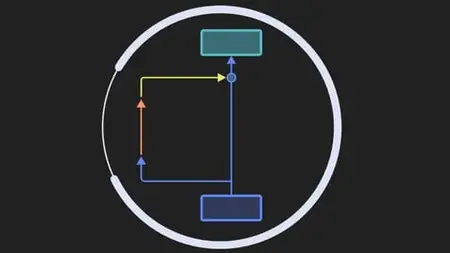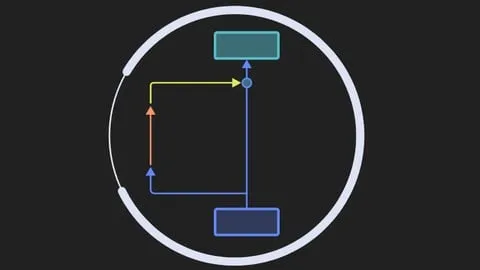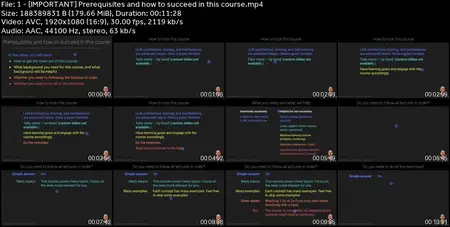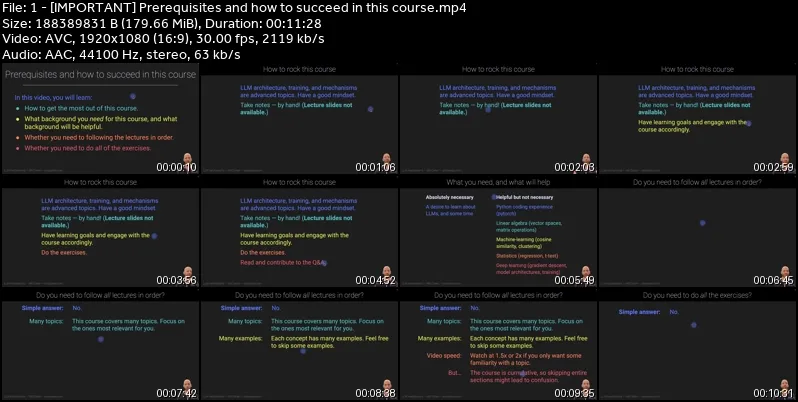A deep understanding of AI large language model mechanisms
2025-08-12
MP4 | Video: h264, 1920x1080 | Audio: AAC, 44.1 KHz
Language: English (US) | Size: 90.97 GB | Duration: 92h 49m
2025-08-12
MP4 | Video: h264, 1920x1080 | Audio: AAC, 44.1 KHz
Language: English (US) | Size: 90.97 GB | Duration: 92h 49m
Build and train LLM NLP transformers and attention mechanisms (PyTorch). Explore with mechanistic interpretability tools
What you'll learn
Large language model (LLM) architectures, including GPT (OpenAI) and BERT
Transformer blocks
Attention algorithm
Pytorch
LLM pretraining
Explainable AI
Mechanistic interpretability
Machine learning
Deep learning
Principal components analysis
High-dimensional clustering
Dimension reduction
Advanced cosine similarity applications
Requirements
Motivation to learn about large language models and AI
Experience with coding is helpful but not necessary
Familiarity with machine learning is helpful but not necessary
Basic linear algebra is helpful
Deep learning, including gradient descent, is helpful but not necessary
Description
Deep Understanding of Large Language Models (LLMs): Architecture, Training, and MechanismsDescriptionLarge Language Models (LLMs) like ChatGPT, GPT-4, , GPT5, Claude, Gemini, and LLaMA are transforming artificial intelligence, natural language processing (NLP), and machine learning. But most courses only teach you how to use LLMs. This 90+ hour intensive course teaches you how they actually work — and how to dissect them using machine-learning and mechanistic interpretability methods.This is a deep, end-to-end exploration of transformer architectures, self-attention mechanisms, embeddings layers, training pipelines, and inference strategies — with hands-on Python and PyTorch code at every step.Whether your goal is to build your own transformer from scratch, fine-tune existing models, or understand the mathematics and engineering behind state-of-the-art generative AI, this course will give you the foundation and tools you need.What You’ll LearnThe complete architecture of LLMs — tokenization, embeddings, encoders, decoders, attention heads, feedforward networks, and layer normalizationMathematics of attention mechanisms — dot-product attention, multi-head attention, positional encoding, causal masking, probabilistic token selectionTraining LLMs — optimization (Adam, AdamW), loss functions, gradient accumulation, batch processing, learning-rate schedulers, regularization (L1, L2, decorrelation), gradient clippingFine-tuning and prompt engineering for downstream NLP tasks, system-tuningEvaluation metrics — perplexity, accuracy, and benchmark datasets such as MAUVE, HellaSwag, SuperGLUE, and ways to assess bias and fairnessPractical PyTorch implementations of transformers, attention layers, and language model training loops, custom classes, custom loss functionsInference techniques — greedy decoding, beam search, top-k sampling, temperature scalingScaling laws and trade-offs between model size, training data, and performanceLimitations and biases in LLMs — interpretability, ethical considerations, and responsible AIDecoder-only transformers Embeddings, including token embeddings and positional embeddingsSampling techniques — methods for generating new text, including top-p, top-k, multinomial, and greedyWhy This Course Is Different93+ hours of HD video lectures — blending theory, code, and practical applicationCode challenges in every section — with full, downloadable solutionsBuilds from first principles — starting from basic Python/Numpy implementations and progressing to full PyTorch LLMsSuitable for researchers, engineers, and advanced learners who want to go beyond “black box” API usageClear explanations without dumbing down the content — intensive but approachableWho Is This Course For?Machine learning engineers and data scientistsAI researchers and NLP specialistsSoftware developers interested in deep learning and generative AIGraduate students or self-learners with intermediate Python skills and basic ML knowledgeTechnologies & Tools CoveredPython and PyTorch for deep learningNumPy and Matplotlib for numerical computing and visualizationGoogle Colab for free GPU accessHugging Face Transformers for working with pre-trained modelsTokenizers and text preprocessing toolsImplement Transformers in PyTorch, fine-tune LLMs, decode with attention mechanisms, and probe model internalsWhat if you have questions about the material?This course has a Q&A (question and answer) section where you can post your questions about the course material (about the maths, statistics, coding, or machine learning aspects). I try to answer all questions within a day. You can also see all other questions and answers, which really improves how much you can learn! And you can contribute to the Q&A by posting to ongoing discussions. By the end of this course, you won’t just know how to work with LLMs — you’ll understand why they work the way they do, and be able to design, train, evaluate, and deploy your own transformer-based language models.Enroll now and start mastering Large Language Models from the ground up.
Who this course is for:
AI engineers, Scientists interested in modern autoregressive modeling, Natural language processing enthusiasts, Students in a machine-learning or data science course, Graduate students or self-learners, Undergraduates interested in large language models, Machine-learning or data science practitioners, Researchers in explainable AI





